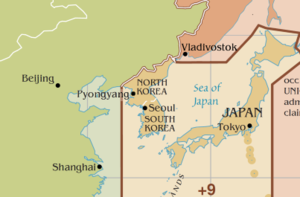Time in North Korea
| Pyongyang Time | |
|---|---|
| Time zone | |
 Map of East Asia with timezones | |
| UTC offset | |
| PYT | UTC+9:00 |
| Current time | |
| 01:15, 24 November 2024 UTC+09:00 [refresh] | |
| Central meridian | |
| Date-time group | |
| Pyongyang Time | |
| Chosŏn'gŭl | |
|---|---|
| Hancha | |
| Revised Romanization | Pyeongyang sigan |
| McCune–Reischauer | Pyŏngyang sigan |
Time in North Korea, called Pyongyang Time[1] (Korean: 평양시간; Hancha: 平壤時間 or PYT) or Standard Time of the Democratic People's Republic of Korea (조선민주주의인민공화국 표준시간; 朝鮮民主主義人民共和國標準時間), is since May 2018 equal to Korea Standard Time: 9 hours ahead of UTC (UTC+09:00). Like South Korea, North Korea does not currently observe daylight saving time.[2] Time keeping in North Korea is under the State Commission for Science and Technology.
History
[edit]Before modern clocks were introduced into Korea, Koreans kept time with the help of a sundial during the daytime and a water clock at night. In 1434, Jang Yeong-sil, a Joseon scientist and astronomer with other scientists, developed Korea's first sundial, Angbu Ilgu (앙부일구; 仰釜日晷) and was put into service as standard time-keeper of the kingdom and began the standard time at Hanyang (Seoul) which was calculated to be UTC+08:27:52.[3] In 1442, Chiljeongsan, an astronomical calendar system that was created during the reign of King Sejong used Hanyang (Seoul) local time as its standard as it overcame the limitations of previous-made calendars.[4] The Korean Empire adopted a standard time of 8½ hours ahead of UTC (UTC+08:30), which is similar to Pyongyang Standard Time, around the beginning of the 20th century. Some sources claim 1908,[5] others claim 1912[6] and yet another claims that mean local standard time was used prior to 1908 and that UTC+08:30 was used from 1 April 1908 to 31 December 1911 and again from 21 March 1954 to 9 August 1961.[7] In 1912, the Governor-General of Korea changed the time zone to UTC+09:00 to align with Japan Standard Time.
On 5 August 2015, the North Korean government decided to return to UTC+08:30, effective 15 August 2015, and said the official name would be Pyongyang Time or (PYT).[8][9] The government of North Korea made this decision as a break from "imperialism"; the time zone change went into effect on the 70th anniversary of the liberation of Korea.[10] The South Korean government officials worried about inconvenience in Inter-Korean exchange and cooperation, including commuting to and from the Kaesong Industrial Region, and further difference of lifestyle between the North and South Korean people.[9]
On 29 April 2018, North Korean leader Kim Jong-un announced his country would be returning to UTC+09:00 to realign its clocks with South Korea. On 30 April 2018, the Supreme People's Assembly of North Korea issued a decree about changing the time zone in North Korea as a further step in unifying Korea and eliminating differences between the South and North.[11][12][13] The time zone change was applied at 23:30 on 4 May 2018 (UTC+08:30).[14][15]
IANA time zone database
[edit]The IANA time zone database contains one zone for North Korea in the file zone.tab, named Asia/Pyongyang.[16]
See also
[edit]References
[edit]- ^ "Decree on Redesignating Pyongyang Time". Naenara. 30 April 2018. Retrieved 4 May 2018.
- ^ "When is Daylight Saving Time Worldwide?". WebExhibits.
- ^ A Bridge between Conceptual Frameworks: Sciences, Society and Technology Studies edited by Raffaele Pisano
- ^ "Archived copy" (PDF). Archived from the original (PDF) on 7 October 2016. Retrieved 6 September 2016.
{{cite web}}: CS1 maint: archived copy as title (link) - ^ Munroe, Tony; Kim, Jack (6 August 2015). Tait, Paul (ed.). "Turning back the clock: North Korea creates Pyongyang Standard Time". Reuters. Archived from the original on 9 August 2015. Retrieved 7 August 2015.
- ^ Ts'ai, Hui-yu Caroline (2009). Taiwan in Japan's Empire-Building: An Institutional Approach to Colonial Engineering. Routledge. p. 97. ISBN 978-0-203-88875-9. LCCN 2008018374. OCLC 227205710.
After Japan took over Taiwan in 1895, the new empire was divided into two standard time zones: central and western; .... In 1912, Korea adopted the central time zone as a result of its merger with Japan in 1910.
- ^ Dershowitz, Nachum; Reingold, Edward M. (2008). "17.10 The Korean Calendar". Calendrical Calculations (3rd ed.). Cambridge University Press. p. 269. ISBN 978-0-521-88540-9. OCLC 144768713. OL 3347485W.
Prior to April 1, 1908 local mean time was used; for some intervals since then, 8.5 hours after U.T. was used as the time zone (from 1 April 1908 to 31 December 1911 and from 21 March 1954 until 9 August 1961).
- ^ "North Korea to introduce new timezone[sic] this month". BNO News. 7 August 2015. Archived from the original on 25 September 2015. Retrieved 7 August 2015.
- ^ a b "North Korea's new time zone to break from "imperialism"". BBC News. 7 August 2015. Retrieved 7 August 2015.
- ^ Mathis-Lilley, Ben (7 August 2015). "North Korea Invents New Time Zone, 'Pyongyang Time'". Slate.
- ^ Westcott, Ben; Yoonjung, Seo; Jeong, Sophie; Watkins, Eli (29 April 2018). "North Korea will close main nuclear test site in May, South says". CNN. Archived from the original on 1 May 2018. Retrieved 29 April 2018.
- ^ "혼란 주던 '30분 시차' 사라진다…서울 표준시로 "통일"" (in Korean). 29 April 2018. Retrieved 29 April 2018.
- ^ "N Korea to adjust time zone to match the South". RTHK. Agence France-Presse. 30 April 2018. Retrieved 30 April 2018.
- ^ "North Korea changes its time zone". BBC News. 5 May 2018. Retrieved 5 May 2018.
- ^ "Time for change: North Korea moves clocks forward to keep up with South". The Guardian. Associated Press. 5 May 2018. Retrieved 9 May 2018.
- ^ "IANA – Time Zone Database". IANA.
External links
[edit]- North Korea at Time and date
- Asia/Pyongyang at Travelmath
- Asia/Pyongyang Archived 12 March 2022 at the Wayback Machine at TWiki
